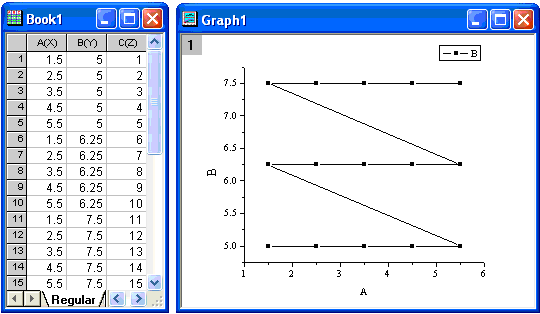
Convert regularly spaced XYZ data to matrix
1. xyz_regular;
2. xyz_regular Col(3);
3. xyz_regular zi:=(1,2,3);
4. xyz_regular mo:=[MyMatrix]Sheet1;
Please refer to the page for additional option switches when accessing the x-function from script
| Display Name |
Variable Name |
I/O and Type |
Default Value |
Description |
|---|---|---|---|---|
| Input | iz |
Input XYZRange |
|
Specifies the input XYZ range. |
| Output Matrix | om |
Output MatrixObject |
|
Specifies the output destination matrix. See the syntax here. |
In order for XYZ worksheet data to be classified as Regular, the XY data must meet the following requirements:
1. Each X value must have the same number of Y values and each Y value must have the same number of X values. And
2. Both the X and the Y data values must be equally spaced. To check for regularity, you canplot the XY data set as a line and symbol graph:

If your data satisfies the above criteria, you can convert your worksheet to a matrix using the Regular method and get a matrix filled with z values:

/* This example shows how convert worksheet data into matrix by regular xyz gridding method. The sample data is exe_path\Samples\Matrix Conversion and Gridding\XYZ Regular.dat. 1. Load data to a new created workbook. 2. Regular xyz gridding conversion. */ // Get sample data fn$ = system.path.program$ + "Samples\Matrix Conversion and Gridding\XYZ Regular.dat"; newbook; impASC fn$; // Set the third column as Z column wks.col3.type = 6; // Convert worksheet data into matrix by regular xyz gridding method xyz_regular 3;
xyz_renka, xyz_renka_nag, xyz_shep, xyz_shep_nag, xyz_sparse, xyz_tps
Keywords:worksheet, gridding